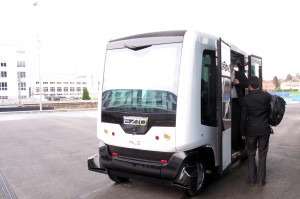Driver-less cars were first tested in the UK last year in Milton Keynes in October. Many of the UK projects are in more urban areas such as the London Borough of Greenwich, and the Government is keen to see the UK become a global leader in the field.
In Japan, local authorities have lead the way with a range of projects which have often been in areas with large populations of older people and where public transport can be expensive and unreliable. This follows a big trend in Japan of using robots for supporting the elderly in all aspects of their lives, such as in Kanagawa Prefecture and specifically Sagami City area where they have supported a large concentration of industries, research centres and university laboratories specialising in research and development of personal assistive robotics. It also has several hospitals and care centres for high dependency patients, constituting an indispensable framework to support the implementing of functionality tests for developing prototypes.
Another local authority in the north of Japan is supporting robotic technology and recently also ran the first tests on public roads of driverless vehicles in the country. Senboku City in Akita Prefecture, as part of the central government’s special economic development zone policy ran driverless bus trials along a 400 meter stretch of road, in a project managed by Japanese internet company DeNA exploring the possibility of introducing automated public transportation systems in sparsely populated areas, on this occasion using French ‘Robot Shuttles’ manufactured by the company EasyMile.
The robot bus uses the global positioning system, sensors and cameras to navigate obstacles, and was the first time that a robot vehicle had been used on a public highway (a previous project had been run off-road in a park in Makuhari, Chiba Prefecture, also by DeNA).
The project is being implemented with two issues in mind, the upcoming Olympic Games in 2020 as a way of transporting visitors and tourists, where public transport will be an issue even for Tokyo’s celebrated efficient and fast transport network with the expected hundreds of thousands of visitors during the games.
The second issue, more relevant to many areas all over Japan, is that of depopulation and aging society. Public transport networks are becoming harder to maintain in the rural parts of Japan, and areas outside the big metropolises (where many older Japanese live) are finding it difficult to keep train lines open. One example emblematic of problems all over Japan is East Japan Rail Company citing these problems as reasons for shutting down stations on the Tadami Line permanently in Fukushima Prefecture after the earthquake of 2011. It was in the red for decades, what with the population of the surrounding towns shrinking from 12,000 in the 1960s to 4,700. The prefecture asked the central government to subsidise the line in order to keep it running, but as JR East is a private company focused on making a profit there is a question of the lines’ sustainability.
Even in the urban areas there are pressures. Seibu Railway Co. reported that the US investment firm Cerberus Capital Management, which bought stock in parent company Seibu Holdings to influence management, proposed restructuring plans that included discontinuing five small regional lines. Cerberus has since said it has no intention to shut down anything, but the Governor of Saitama (adjacent to Tokyo), where one of these targeted lines is located, has publicly asked Seibu to ensure the line remains in operation.
With these pressures on rural lines, robot transport may be a sustainable alternative as part of the overall trend of robotisation. With central and local government investing more and becoming more focused on robot technology in other areas of supporting Japan’s ageing society, the impact of the technology could be felt not just within the country but overseas as well, as Japan’s private sector who have invested in robot development seeks to market its products globally.
Photograph by courtesy of Rama/Creative Commons Attribution-Share Alike 2.0 France


